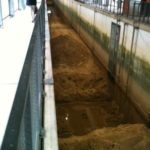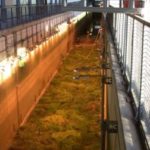Salt marshes as sea defences
Salt marsh ecosystems are important to the local, regional, and global community for many reasons, these include providing a buffer against waves and tidal currents.
However, such ecosystems are under increasing pressure from sea-level rise, changes to wind wave climates, and more direct human pressures such as grazing, which alter their functioning and potentially threaten their survival over the longer term.
The experiment
To build coastal vegetation into coastal protection schemes, we need to understand how it is affected by, and how it affects, waves. A European Group of Researchers* will conduct an experiment on how waves change when they travel across submerged salt marsh vegetation. The experiment will be carried out in the large wave flume in Hannover, one of the largest experimental flume facilities worldwide. For this project, a 200 m2 test section of marsh turf, excavated in July 2012, will be exposed to a range of wave conditions and water depths in a series of experimental runs in the autumn of 2013. Conditions will range from those encountered during an average high tide to those encountered only very rarely during a storm.
Reconstructing a salt marsh inside a flume is a massive task.


Visit The Salt Marsh Experiment Blog for an insight into how a 200m2 salt marsh is constructed and watch the time lapse video.
For more technical information visit the CCRU website.
*The Cambridge Coastal Research Unit (CCRU), in collaboration with Deltares (NL), the University of Hamburg (Germany), the Netherlands Centre for Estuarine and Marine Ecology (NIOO-CEME, NL) and the University of Hannover (Germany) has obtained funding under the EU Hydralab IV.
